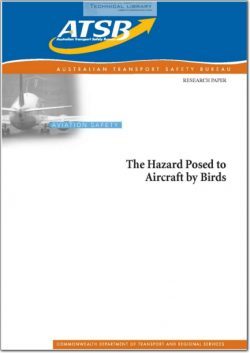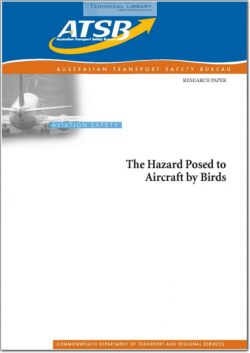ATSB-RP-2002-11

- Version
- 196 Downloads
- 370.63 KB File Size
- 1 File Count
- August 9, 2016 Create Date
- August 9, 2016 Last Updated
The Hazard Posed to Aircraft by Birds

Birdstrikes continue to be a problem for aviation worldwide, costing approximately
$US3 billion annually. Increasingly, funds are being directed towards research which
focuses on bird control and avoidance methods. Two such methods which are proving
to be successful, are the use of hand held laser devices to scare birds from the airport
environment, and the use of the US developed Avian Hazard Advisory System (AHAS),
which allows aircraft to avoid high-risk birdstrike areas.
This study investigated the Australian birdstrike data for the period 1991 to 2001.
Although limited, the available data was able to be used to investigate birdstrike rates,
species involvement and hazard potentials, as well as providing a time of day and phase
of flight analysis. Additionally, the current study highlights the magnitude of some of
the impact forces exerted during a birdstrike. The data suggest that there has been a
significant increase in the rate of birdstrikes being recorded in Australia since 1992
(most notably between 1998 and 2001). It is unclear whether this is the result of an
increasing strike hazard or an improving reporting culture. Both the International Civil
Aviation Organisation (ICAO) and Australian data indicate that the majority of strikes
occur on, or in the vicinity of, the airport environment, during the take off, approach or
landing phases of flight.
An analysis of the strike data revealed that birdstrikes are most common during the
earlier months of the year (January to May) and are at their lowest between June and
August. The specific monthly pattern varies between locations, particularly between
airports in the north and south of Australia: with airports in the north of Australia
generally recording higher strike rates. The data also suggests that strikes are most
common at dawn, and during the early morning and late afternoon periods of the day.
However, this may be an artefact of aircraft activity levels during these times.
The hawk and the galah are the most commonly struck birds in Australia. However, the
eagle and the ibis pose the most serious hazard to aircraft if struck. Development of
‘most struck’ and ‘potential hazard’ lists allow airport owners and operators to develop
and prioritise control methods to suit their specific area.
All birdstrikes and bird hazards, no matter how insignificant they might appear, must
be reported to the Australian Transport Safety Bureau (ATSB). An improved reporting
culture will allow a more thorough and comprehensive understanding of the bird
hazard situation, which should in turn lead to the implementation of more effective
control and management strategies.
| File | Action |
|---|---|
| ATSB-RP-2002-11 The Hazard Posed to Aircraft by Birds.pdf | Download |

Comment On This Post